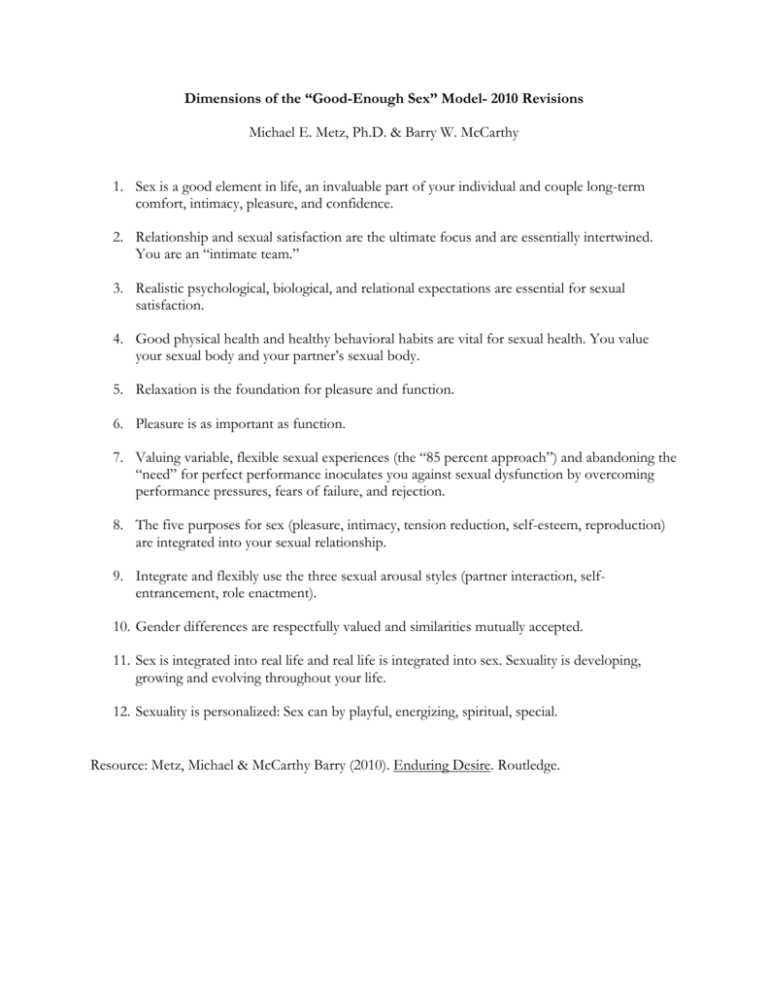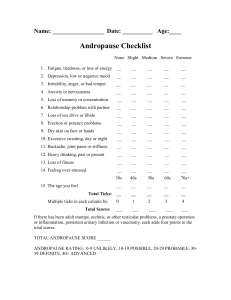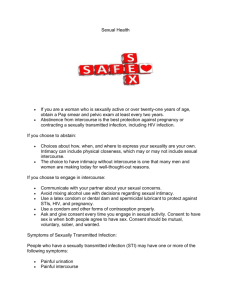
Dimensions of the “Good-Enough Sex” Model- 2010 Revisions
Michael E. Metz, Ph.D. & Barry W. McCarthy
1. Sex is a good element in life, an invaluable part of your individual and couple long-term
comfort, intimacy, pleasure, and confidence.
2. Relationship and sexual satisfaction are the ultimate focus and are essentially intertwined.
You are an “intimate team.”
3. Realistic psychological, biological, and relational expectations are essential for sexual
satisfaction.
4. Good physical health and healthy behavioral habits are vital for sexual health. You value
your sexual body and your partner’s sexual body.
5. Relaxation is the foundation for pleasure and function.
6. Pleasure is as important as function.
7. Valuing variable, flexible sexual experiences (the “85 percent approach”) and abandoning the
“need” for perfect performance inoculates you against sexual dysfunction by overcoming
performance pressures, fears of failure, and rejection.
8. The five purposes for sex (pleasure, intimacy, tension reduction, self-esteem, reproduction)
are integrated into your sexual relationship.
9. Integrate and flexibly use the three sexual arousal styles (partner interaction, selfentrancement, role enactment).
10. Gender differences are respectfully valued and similarities mutually accepted.
11. Sex is integrated into real life and real life is integrated into sex. Sexuality is developing,
growing and evolving throughout your life.
12. Sexuality is personalized: Sex can by playful, energizing, spiritual, special.
Resource: Metz, Michael & McCarthy Barry (2010). Enduring Desire. Routledge.
Arousal and Erection Guidelines- 2010 Revision
Barry W. McCarthy, Ph.D.
American University/Washington Psychological Center
1.
By age forty, 90 percent of males have experienced at least one erectile failure (not being able
to attain or maintain an erection sufficient for intercourse). This is a normal occurrence, not
a sign of erectile dysfunction (ED).
2.
The majority of erectile problems (especially for men under 50) are caused primarily by
psychological or relationship factors, not medical or physiological malfunctions. To
comprehensively evaluate medical factors, including side effects of medication, consult a
urologist with training in erectile function and dysfunction.
3.
ED can be caused by a wide variety of factors including alcohol abuse, anxiety, depression,
vascular or neurological deficits, distraction, anger, side effects of medication, frustration,
hormonal deficiency, fatigue, not feeling sexual at that time or with that partner. As men
age, the hormonal, vascular and neurological systems become less efficient so psychological,
relational, and erotic factors become more important.
4.
Medical interventions, especially the oral medication, Viagra, can be a valuable resource to
facilitate erectile function, but is not a magic pill. The couple need to integrate Viagra (or
other medical interventions) into your lovemaking style.
5.
Do not believe the myth of the male machine, ready to have intercourse at any time, with
any woman, in any situation. You and your penis are human. You are not a performance
machine.
6.
View the erectile difficulty as a situational problem, do not overreact and label yourself
impotent or put yourself down as a failure.
7.
A pervasive myth is if a man loses his initial erection, it means he is sexually uninterested or
turned off. It is a natural physiological process for erections to wax and wane during
prolonged pleasuring. Actually, almost all men prefer to transition to intercourse and orgasm
on the first erection, but do not make this a performance demand.
8.
In a forty-five-minute pleasuring session, erections will wax and wane two to five times.
Subsequent erections, intercourse, and orgasm are quite satisfying.
9.
You do not need an erect penis to satisfy a woman. Orgasm can be achieved through
manual, oral, or rubbing stimulation. If you have difficulty getting or maintaining an
erection, do not stop the sexual interaction. She finds it arousing to have your fingers,
tongue, or penis (erect or flaccid) used for stimulation.
10.
Actively involve yourself in giving and receiving pleasurable and erotic touching. Erection is
a natural result of pleasure, feeling turned-on, and eroticism.
11.
You cannot will or force an erection. Do not be a "passive spectator” who is distracted by
the state of your penis. Anticipatory anxiety and performance anxiety can cause ED. Sex is
not a spectator sport, it requires active involvement.
12.
Allow the woman to initiate intercourse and guide your penis into her vagina. This reduces
performance pressure and, since she is the expert on her vagina, is the most sexually inviting
and practical procedure.
13.
Feel comfortable saying, “I want sex to be pleasurable and playful. When I feel pressure to
perform, I get uptight and sex is not good. We can make sexuality enjoyable by taking it at a
comfortable pace, enjoy playing and pleasuring, and being an intimate team.”
14.
Erectile problems do not effect the ability to ejaculate (you can ejaculate with a flaccid
penis). The man relearns ejaculation to the cue of an erect penis.
15.
One way to regain confidence is through masturbation. During masturbation you can
practice gaining and losing erections, relearn ejaculation with an erection, and focus on
fantasies and stimulation which are transferable to partner sex.
16.
Do not try to use a waking erection for quick intercourse. This erection is associated with
REM sleep and results from dreaming and being close to the partner. Men try vainly to have
intercourse with the morning erection before losing it. Remember: arousal and erection are
regainable. Morning is a good time to be sexual.
17.
When sleeping, you have an erection every ninety minutes--three to five erections a night.
Sex is a natural physiological function. Do not block it by anticipatory anxiety, performance
anxiety, distraction, or putting yourself down. Give yourself (and the partner) permission to
enjoy the pleasure of sexuality.
18.
Make clear, direct, assertive requests (not demands) for stimulation you find pleasurable and
erotic. Verbally and nonverbally guide the partner in how to pleasure and arouse you.
19.
Stimulating a flaccid penis is counterproductive. You become distracted and obsessed with
the state of your penis. Engage in sensuous, playful, non-demand touching. Enjoy giving
and receiving stimulation rather than trying to “will an erection.”
20.
Attitudes and self thoughts affect arousal. The key is “sex and pleasure” not “sex and
performance.”
21.
Ideally, 85% of encounters will flow to intercourse. When that does not happen, you can
transition (without panicking or apologizing) to an erotic, non-intercourse scenario on a
cuddly, sensual scenario.
22.
A sexual experience is best measured by pleasure and satisfaction, not whether you had an
erection, how hard it was, or whether she was orgasmic. Some sexual experiences will be
great for both, some better for one than the other, some mediocre, and others unsuccessful.
Do not put your sexual self-esteem on the line at each experience. The “good enough sex”
model of male and couple sexuality is much healthier than the perfect intercourse
performance criterion.
Resource: Metz, Michael and McCarthy, Barry (2004). Coping With Erectile Dysfunction. New
Harbinger.
Guidelines for Revitalizing and Maintaining Sexual Desire
Barry W. McCarthy, Ph.D.
Washington Psychological Center
American University
1. The keys to sexual desire are positive anticipation and feeling you deserve sexual satisfaction in
your relationship.
2. Each person is responsible for his/her desire with the couple functioning as an intimate team to
nurture and enhance desire. Revitalizing sexual desire is a couple task. Guilt, blame, and pressure
subvert the change process.
3. Inhibited desire and conflicts over desire discrepancies is the most common sexual dysfunction,
effecting one in three couples. Desire problems drain intimacy and good feelings from your
relationship.
4. One in five married couples has a non-sexual marriage (being sexual less than ten times a year).
One in three non-married couples who have been together two years or longer have a nonsexual relationship.
5. The initial romantic love/passionate relationship phase which fires desire lasts less than two
years and often less than six months. Desire in ongoing relationships is maintained by
developing a comfortable, functional couple sexual style.
6. The essence of sexuality is giving and receiving pleasure-oriented touching. The prescription to
revitalize and maintain sexual desire is intimacy, pleasuring, and eroticism.
7. Touching occurs both inside and outside the bedroom. Touching is valued for itself, touching
does not always lead to intercourse.
8. Couples who maintain a vital sexual relationship can use the metaphor of touching as having
“five gears”. First gear is clothes on, affectionate touch (holding hands, kissing, hugging).
Second gear is non-genital, sensual touch, which can be clothed, semi-clothed, or nude (nongenital body massage, cuddling on the couch, holding and caressing, touching going to sleep or
on awakening). Third gear is playful touching which intermixes genital and non-genital
touching, clothed or unclothed, romantic or erotic dancing, touching in the bath or shower, on
the couch or in bed, whole body massage, playing strip poker or Twister. Fourth gear is erotic
touching (manual, oral, rubbing, or vibrator stimulation) to high arousal and orgasm for one or
both partners. Fifth gear integrates pleasurable and erotic touch, which flows into intercourse.
Intercourse is a natural continuation of the pleasuring/eroticism process, not a sex pass-fail test.
9. Both the man and woman value affectionate, sensual, playful, erotic, and intercourse
experiences.
10. Both the man and woman are comfortable initiating touching and intercourse. Both feel free to
say "no" and suggest an alternative way to connect and share pleasure.
11. A key strategy is to develop "her," "his," and "our" bridges to sexual desire. This involves ways
of thinking, talking, anticipating, and feeling which invite being sexual.
12. Sexuality has a number of positive functions for the relationship--a shared pleasure, a means to
reinforce and deepen intimacy, and a tension reducer to deal with the stresses of life and a
relationship.
13. The average frequency of sexual intercourse is from four times a week to once every two weeks.
For couples in their twenties, it is two-three times a week, couples in their fifties once-twice a
week.
14. Personal turn-ons (fantasies, special celebrations or memories, feeling caring and close,
anniversaries or birthdays, sex with the goal of pregnancy, initiating a favorite erotic scenario,
being playful or spontaneous, sexuality to celebrate a career success or sooth a personal
disappointment) facilitate sexual anticipation and desire.
15. External turn-ons (R or X-rated videos, music, candles, sex toys, visual feedback from mirrors,
being sexual outside the bedroom, a weekend away without the kids) facilitate anticipation and
desire.
16. Non-demand pleasuring can be a way to connect physically, a means to share pleasure and/or a
bridge to sexual desire.
17. "Intimate coercion" is not acceptable. Sexuality is neither a reward nor a punishment. Sexuality
is voluntary, and pleasure-oriented.
18. Realistic expectations are crucial for maintaining a vital sexual relationship. It is self-defeating
and harmful to demand equal desire, arousal, orgasm and satisfaction each time. Realistically,
thirty-five to forty-five percent of experiences are very good for both people. Twenty percent
are very good for one (usually the man) and okay for the other. Fifteen to twenty percent are
okay for one and the other finds it acceptable. Be aware that five to fifteen percent of sexual
experiences are dissatisfying or dysfunctional. Couples who accept occasional mediocre or
dysfunctional experiences without guilt or blaming and try again when they are aware and
receptive have a vital, resilient sexual relationship. Satisfied couples use the guideline of “good
enough sex” with positive, realistic sexual expectations.
19. Contrary to the myth that "horniness" occurs after not being sexual for weeks, desire is
facilitated by a regular rhythm of sexual activity. When sex is less than twice a month, you can
become self-conscious and fall into a cycle of anticipatory anxiety, tense and unsatisfying sex,
and avoidance.
20. Healthy sexuality plays a positive, integral role in your relationship, fifteen-twenty percent, with
the main function to energize your bond and generate special feelings of desire and desirability.
Paradoxically, conflictual or non-existent sex plays a more powerful negative role in a
relationship than the positive role of good sex.
Resource: McCarthy, Barry and McCarthy, Emily (2003). Rekindling Desire.
Brunner/Routledge.
Guidelines for Overcoming Ejaculatory Inhibition- 2010 Revision
Barry W. McCarthy, Ph.D.
American University/ Washington Psychological Center
1. Ejaculatory inhibition (EI) is the least recognized male sexual dysfunction. It occurs in 1-2%
of young males and 8-15% of men over 50.
2. EI refers to the inability (or great difficulty) to be orgasmic even though physically aroused
and erect. The most common type is the inability to reach orgasm during intercourse,
although some men are also unable to be orgasmic with partner manual or oral stimulation.
The great majority of men with EI are able to be orgasmic during masturbation.
3. The traditional derogatory terms for EI were “retarded ejaculation” or “ejaculatory
incompetence.” Ejaculatory inhibition (another term is “delayed ejaculation”) is a descriptive
and non-pejorative term that describes the reality- the man’s natural erotic flow leading to
orgasm is inhibited.
4. Many men try to minimize or hide the problem from the partner, feeling he can satisfy
himself later. In truth, the woman has a positive, integral role in helping overcome EI and
increase pleasure, eroticism, and satisfaction.
5. Young males with primary EI are mistakenly viewed as “studs” who can service and satisfy
women and are admired by male peers who suffer from premature ejaculation. In truth, sex
is less enjoyable for the man, as he is performing for the woman and to impress male peers.
6. The key issue in understanding EI is the difference between subjective and objective arousal.
You may look fully aroused, with a firm erection and vigorous thrusts, but your body is
“telling a lie.” If “0”= neutral, “5”= beginning levels of arousal, “8”= erotic flow, and “10”=
orgasm, your subjective arousal is really “2-4”, even though your objective arousal appears to
be “9.”
7. The key to changing EI is to emphasize subjective pleasure, involve the woman as your
intimate, erotic friend. Delay the transition to intercourse until subjective arousal is at least
“7” and preferably “8.”
8. The two key techniques are to use multiple stimulation during intercourse and to identify
and utilize “orgasm triggers.”
9. Cognitively, you can learn to associate sexuality with comfort, pleasure, and the women as
your intimate, erotic friend; behaviorally you learn to integrate subjective and objective
arousal, enjoy interactive sexuality, request erotic and multiple stimulation, and feel
comfortable using orgasm triggers; emotionally you enjoy the pleasuring process, feel you
have a right to sexual pleasure, enjoy the erotic flow which naturally culminates in orgasm,
and value the “good enough sex” model rather than have to achieve perfect
intercourse/orgasm performance.
10. As men age, especially after 50, rates of intermittent EI increase to between 8-15%. Men
often mislabel the problem as erectile dysfunction because you lose your erection during
intercourse. If intercourse lasts more than 2 minutes the real issue is probably EI- you lose
your erection because you run out of sexual energy.
11. A number of factors can cause intermittent EI including side effects of medication, not
feeling sexually receptive or responsive, alcohol or drug abuse, lack of partner involvement,
fatigue. However, the most common cause is that you experience sex as routine and
mechanical. As a young man you only needed intercourse thrusting, but now your subjective
and objective arousal is muted.
12. EI can lead to male inhibited desire, sexual avoidance, a non-sexual relationship, and
avoidance of all touch.
13. To overcome EI, you need to turn to your partner for emotional encouragement and sexual
stimulation. Unlike the strong, silent “John Wayne” model, you need to view your partner as
your intimate, erotic friend and make requests for multiple stimulation. During intercourse,
orgasm/ejaculation is a natural continuation of the comfort/pleasure/arousal/erotic flow
process, not a pass-fail test.
14. EI is different than the normal physiological transition of men over 60 who have a lessened
need to orgasm at each sexual opportunity. With EI you want to let go and ejaculate, but you
can’t because your subjective arousal is low.
15. The man (and couple) can experiment with a range of multiple stimulation scenarios and
techniques and learn what is good for you. These can include rubbing your penis between
her breasts and manually stimulating her clitoral area; standing while she orally stimulates
you; moving rhythmically; erotic fantasies can accompany any of these scenarios. You can
change intercourse positions two or three times; ask for testicle or anal stimulation; change
intercourse movement from slow in/out to circular thrusting; transition from intercourse to
manual stimulation and back to intercourse at high levels of erotic flow.
16. “Orgasm triggers” are very individualistic- they allow you to move from “9” to “10”
(orgasm/ejaculation). Use orgasm triggers when you are in an erotic flow (not when your
subjective arousal is “5”). Examples of orgasm triggers include: tensing pelvic muscles and
moving in fast, rhythmic thrusts; focusing on an erotic fantasy and reaching orgasm both in
fantasy and in reality; verbalizing “it feels so good I’m going to come”; feeling highly aroused
by your partner’s arousal and “piggy-backing” your orgasm on hers.
17. It is natural and healthy to use self-stimulation during partner sex to enhance your arousal,
including to the point of orgasm.
18. Men and couples have different preferences for pleasuring and eroticism- manual, oral,
rubbing, and/or intercourse stimulation. Some prefer taking turns and others mutual
stimulation. Most prefer multiple stimulation, but some single stimulation. Discover and
enjoy your style of sexual pleasure, arousal, erotic flow, and orgasm.
19. Remember, the essence of healthy couple sexuality is sharing desire, pleasure, and
satisfaction. Enjoy your sexuality; do not view orgasm as the pass-fail test. In “good enough”
male and couple sex, 85% of experiences will involve erotic flow, which naturally culminates
in orgasm.
Resource: McCarthy, Barry and Metz, Michael (2009). Men’s Sexual Health. Routledge.








